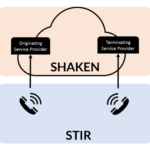Call spam has become a prevalent problem, causing inconvenience and posing privacy and security risks for individuals and businesses. In this comprehensive guide, we will explore various strategies to effectively combat call spam.
Understanding Call Spam
Call spam refers to unsolicited calls that aim to scam, market products, or gather personal information. It is crucial to understand the different forms of call spam and the risks associated with them. Reports from regulatory agencies indicate a significant increase in call spam incidents, affecting millions of people each year.
Some of the common types of call spam are:
- Robocalls: These are automated calls that use a recorded message to deliver a sales pitch or a scam. They often spoof caller IDs to appear as legitimate numbers or local numbers.
- Vishing: This is a form of phishing that uses voice calls to trick people into revealing sensitive information, such as bank account details, passwords, or social security numbers. The callers may pretend to be from reputable organizations or government agencies and create a sense of urgency or threat.
- Wangiri: This is a type of call spam that involves calling a number and hanging up after one ring. The goal is to entice the recipient to call back, which may result in high charges or fees. The callers may use international or premium-rate numbers to generate revenue.
Call spam can have serious consequences for individuals and businesses, such as:
- Loss of money: Call spam can result in financial losses due to fraud, identity theft, or unwanted charges. For instance, scammers may ask for upfront payments, personal information, or access codes to steal money from bank accounts or credit cards.
- Loss of time: Call spam can waste time and resources by interrupting daily activities, work productivity, or customer service. For instance, robocalls can clog phone lines and prevent legitimate calls from getting through.
- Loss of trust: Call spam can erode trust and confidence in phone communication and legitimate organizations. For instance, spoofing can damage the reputation of businesses or government agencies whose numbers are used by scammers.
Types of Call Spam Detection Methods
Manual Call Screening Manual call screening is a primary method for combating call spam. By familiarizing yourself with common indicators, you can identify potential spam calls and avoid answering them. Look for suspicious caller IDs, persistent calls from unfamiliar numbers, or automated voices prompting immediate action.
Suspicious caller IDs are a clear red flag. Scammers often manipulate caller ID information to appear as trusted entities or local numbers. If the caller ID seems suspicious or doesn’t match the expected caller, it’s best to be cautious and refrain from answering.
Persistent calls from unfamiliar numbers can also indicate call spam. Scammers often make repeated attempts to reach you. If you receive multiple calls from the same unknown number without any legitimate reason, it’s likely a spam call.
Automated voices commonly found in robocalls are another indicator of call spam. These pre-recorded messages often present urgent situations or too-good-to-be-true offers. It’s important to be wary of such calls and avoid engaging with the automated prompts.
Call Blocking Methods Implementing call blocking methods can effectively ward off call spam. Here are some techniques to consider:
Device-Based Call Blocking: Many smartphones offer built-in call blocking features. Explore your device’s settings to enable call blocking or call filtering options. You can block calls from specific numbers, unknown numbers, or private numbers.
Third-Party Call Blocking Solutions: There are various call blocking solutions available that can help filter out unwanted calls. These solutions often utilize extensive databases of known spam numbers to identify and block spam calls. Research and choose a reputable call blocking service that suits your needs.
Caller ID and Reverse Phone Lookup Utilizing caller ID and reverse phone lookup tools can provide valuable insights about incoming calls. Caller ID displays the caller’s name or number, helping you decide whether to answer. Reverse phone lookup services allow you to investigate unknown numbers by searching them online, revealing user reports and potentially identifying spam callers.
Caller ID is a common feature available on most smartphones. It allows you to see the name or number associated with an incoming call. By checking the caller ID, you can quickly determine if the call is from a known contact or a potential spam caller.
Reverse phone lookup services enable you to research unknown numbers by entering them into online directories or search engines. This can help uncover information such as user reports or associations with known spam calls.
Best Practices for Call Spam Prevention
Registering with Do Not Call Registries Registering your phone number with Do Not Call registries can help minimize unwanted telemarketing calls. Research the relevant regulatory authorities in your country and follow their procedures to add your number to the Do Not Call list.
Call Filtering and Whitelisting Explore call filtering options on your device or through call blocking services. You can set criteria for incoming calls, such as blocking calls from private or unknown numbers. Whitelisting allows you to create a list of trusted contacts, ensuring that only those calls get through.
Reporting and Sharing Call Spam Incidents Reporting and sharing call spam incidents can help raise awareness and prevent others from falling victim to scammers. You can report call spam to the appropriate authorities, such as the Federal Trade Commission (FTC) in the US or the Canadian Radio-television and Telecommunications Commission (CRTC) in Canada. You can also share your experience on online platforms, such as forums, blogs, or social media, to warn others about potential spam calls.
Call spam is a pervasive and annoying problem that can have serious implications for individuals and businesses. However, by following the strategies outlined in this guide, you can effectively combat call spam and protect yourself from unwanted calls. Remember to:
- Screen calls manually by looking for suspicious caller IDs, persistent calls from unknown numbers, or automated voices.
- Block calls using device-based or third-party solutions that can filter out spam calls based on various criteria.
- Use caller ID and reverse phone lookup tools to identify and research incoming calls and gain more information about the callers.
- Register with Do Not Call registries to reduce telemarketing calls and opt out of unwanted communications.
- Report and share call spam incidents to the relevant authorities and online communities to help stop scammers and raise awareness.
By following these steps, you can enjoy a more secure and hassle-free phone experience.



